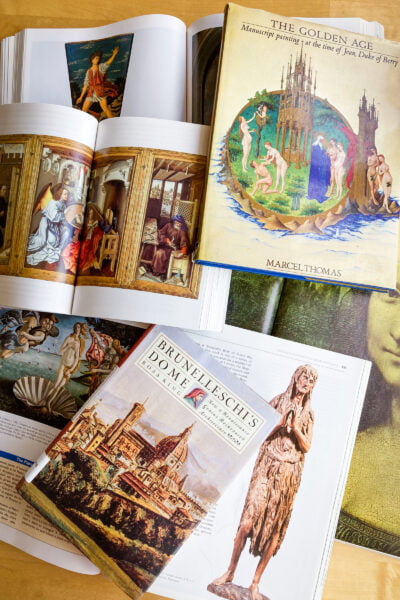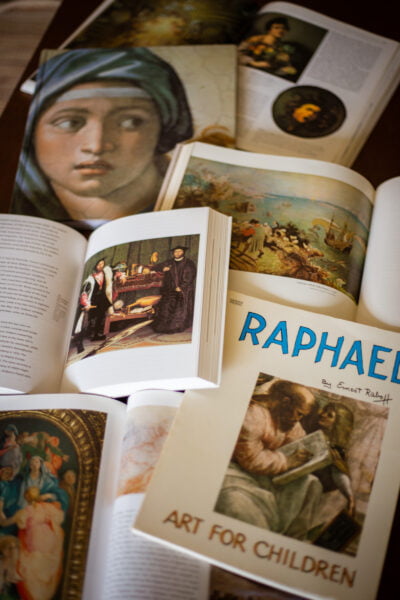25 Artists from the 1900s to Include in Your Picture Study Time

The 1900s included many artists who are prime candidates for your picture study time. Numerous new movements dominated the art world during this time, even while more traditional styles continued to thrive, and artists of color and female artists began gaining more traction and recognition during this time as well.
In this week’s post, I’m sharing a list of some excellent options for picture study from the 1900s! As I mentioned last month, these are certainly not the only ones to explore, especially as the 20th century included so many different kinds of styles, many of which were particularly abstract. These are, however, some of the ones I’ve enjoyed learning more about either in my college classes or later on as I have pursued more art history knowledge on my own.
I’ve again tried to include a range of styles, nationalities, and perspectives; however, if you see an artist you feel should be listed here, feel free to leave a comment below!
The Artists
Alphonse Mucha

Nationality: Moravian
Movement: Art Nouveau
Alphonse Mucha (1860-1939) is a fitting artist to begin this list, as he is one of my personal favorites. His art elevated everyday goods with beauty, but more poignant is his devotion to his culture (a running theme in his art) and his people – the Slavs – who were eternally living in fractured groups around Eastern Europe. His “Slav Epic” cycle of massive paintings illustrates the history of the Slavic people, and one of these years, I’d love to see it in person. (Also, fun fact: if you happen to be in North Dakota, you can see his work at St. John Nepomucene Catholic Church in Pisek.)
Alfredo Andersen

Nationality: Norwegian (active in Brazil)
Movement: Impressionism
Alfredo Andersen (1860-1935) was born in Norway but spent most of his life in Brazil after his ship crashed there in the early 1890s. Ironically, he is known as the “father of Paranaense painting” and his oeuvre includes primarily landscapes of the area in Brazil where he lived (Paraná).
Elin Danielson-Gambogi

Nationality: Finnish
Movement: Realism
Elin Danielson-Gambogi (1861-1919) was a Finnish female artist who lost her father at a young age to suicide and she and her sister were raised by her mother alone. Her art has a more feminine feel than other Realist artists of her era and she was truly a master of light.
Mikhail Vasilyevich Nesterov

Nationality: Russian
Movement: Symbolism
Mikhail Nesterov (1862-1842) followed in the footsteps of his Russian Peredvizhniki predecessors (see Artists of the 1800s list for a few of these) in creating images that seem alive with light and color. His paintings are very detailed, but quiet, and capture scenes from everyday life. (His “Nativity” is included in my Advent Art Devotions Volume I.)
Wassily Kandinsky

Nationality: Russian
Movement: Bauhaus/Expressionism/Abstract
Wassily Kandinsky (1866-1944) lived during a time of many changes in the art world, and the various styles he experimented with reflect that evolution. He went from somewhat more traditional styles that reflected Impressionism to much more abstract styles later in his life.
Henri Matisse

1908
(used under fair use doctrine)
Nationality: French
Movement: Fauvism/Modernism/Neo-Impressionism/Primitivism
Henri Matisse (1869-1954) is another artist who went through several different art movements throughout his career. His work is generally characterized by bright colors and bold shapes.
Xavier Martinez

Nationality: Mexican (active in the United States)
Movement: Tonalism
Xavier Martinez (1869-1943) was born in Guadalajara, Mexico where he received his early artistic training. After his mother died, he moved to the United States with his adoptive family and explored the tonalist style. His paintings are muted and evoke a sense of calm.
Maxfield Parrish

(used under fair use doctrine)
Nationality: American
Movement: Symbolism
Maxfield Parrish (1870-1966) is grouped into the Symbolist movement, but his style and subject matter were unique to him and his paintings are highly recognizable. Every time I see a sunset with peach and purple clouds in the sky, he comes to mind. His paintings evoke classical scenes and are very beautiful.
Emily Carr

Nationality: American
Movement: Sculpture
Emily Carr (1871-1945) was a female Canadian artist who explored different subjects at length throughout her life. She captured the last vestiges of the First Nations people around the island of Vancouver early in her career and then later shifted her focus to the landscape and forests of that area. She was a unique woman with a unique style.
Olowe of Ise

Nationality: Yoruba (Nigerian)
Movement: Sculpture (Oju-ona)
Olowe of Ise (ca. 1873 – ca. 1938) is recognized as a key figure in the art of Yorubaland. He was highly skilled in sculpture and caught the attention of his king for whom he made many pieces. His work is a beautiful example of the aesthetics of the Yoruba people.
Hiroshi Yoshida

Nationality: Japanese
Movement: Taishō period/Shōwa period (Shin-Hanga)
Hiroshi Yoshida (1876-1950) Japanese artist who continued the practice of woodblock painting even after it grew less popular in Japan, though he gave his prints more depth and dimensionality than his predecessors. He traveled widely and his work can be seen outside of Japan as well.
Anna Hyatt Huntington

(Photo by Jim Henderson)
Nationality: American
Movement: Sculpture
Anna Hyatt Huntington (1876-1973) is known for her beautiful and usually dramatic sculptures. As a female sculptor in the early part of the 19th century, she faced a lot of prejudice, but the quality of her work and the sheer number of pieces she created testify to her talent and resilience.
Meta Vaux Warrick Fuller

Nationality: American
Movement: Harlem Renaissance
Meta Vaux Warrick Fuller (1877-1968) was another sculptress who faced tremendous prejudice as she was not only a woman but also African-American. Her work includes many pieces inspired by African-American experiences in the United States.
Pablo Picasso

Nationality: Spanish
Movement: Cubism
Pablo Picasso (1881-1973) is one of the most well-known names of 20th-century art and is the first artist who comes to mind when the topic of Cubism is discussed. He also explored other styles, represented by the painting above, which would be interesting to contrast during picture study.
Edward Hopper

Nationality: American
Movement: Realism
Edward Hopper (1882-1967) captured moments with his paintbrush that have the feeling of photographs. His work uses bold colors to represent scenes of everyday life in America in the first half of the 20th century, especially between World War I and World War II.
Georges Braque

Nationality: French
Movement: FAUVISM/Cubism
Georges Braque (1882-1963), along with Pablo Picasso, was another pioneer in the Cubist movement, though his early work, which is bright and colorful, demonstrates his beginnings in Fauvism. His later work reflects his experimentation with Cubism in its various forms and is more abstract.
Georgia O’Keeffe

Nationality: American
Movement: Precisionism
Georgia O’Keeffe (1887-1986) is so closely aligned with the American southwest that a part of New Mexico is referred to as “O’Keeffe Country.” Her art is somewhat abstract and offers an interesting contrast to more classic styles.
Laura Wheeler Waring

Nationality: American
Movement: Harlem Renaissance
Laura Wheeler Waring (1887-1948) was an African-American painter known for her portraits, particularly those of other African Americans. She was especially gifted in using color and texture in her paintings.
Thomas Hart Benton

(used under fair use doctrine)
Nationality: American
Movement: American Realism/Regionalism/Synchromism
Thomas Hart Benton (1889-1975) is considered part of the American realism/regionalism movements, but his art is distinct. His figures are almost sculptural in their form, and he tends to condense scenes into a small space to increase the emotions they evoke.
Grant Wood

Nationality: American
Movement: American Realism/Regionalism
Grant Wood (1891-1942) painted one of the most iconic images in American history. Ironically, the one painting for which he is most well-known is in a different style than the majority of his other pieces, which would be an interesting detail to explore.
Norman Rockwell

Nationality: American
Movement: American Realism/Regionalism
Norman Rockwell (1894-1978) is so often associated with Americana that his paintings are a visual timeline of American history from his early, more quaint work from the early part of the 20th century to his more social and historical work of the 1960s. He was very talented and produced highly detailed work.
Xu Beihong

Nationality: Chinese
Movement: American Realism/Regionalism
Xu Beihong (1895-1953) was a Chinese artist who painted in both more traditional Chinese styles as well as western styles. His art includes scenes from nature as well as animals, especially birds and horses.
Aaron Douglas

Nationality: American
Movement: Harlem Renaissance
Aaron Douglas (1899-1979) was an African-American painter who created many scenes highlighting the history and struggle of Black Americans. While inspired by other movements like Cubism, I think Douglas’s style is very unique, simple in its execution, but profound in its statements.
Andrew Wyeth

(used under fair use doctrine)
Nationality: American
Movement: American Realism/Regionalism
Andrew Wyeth (1917-2009) was the son of illustrator N.C. Wyeth. Hints of his father’s style can be seen in his work, but his style was unique, and his subject matter was more biographical.
Richard Estes

(used under fair use doctrine)
Nationality: American
Movement: hyper-realism/Photorealism
Richard Estes (b. 1932) is part of the hyper-realism (or photorealism) movement, and his paintings are difficult to tell apart from photographs. He focuses particularly on urban scenes, but his more recent work has ventured into different parts of the world.
Of course there are many, many other artists who could be added to this list, especially more recent ones. These 25, however, are a good place to start! Who would you add?
Other posts in this series:















This has been an excellent discovery! I love that the art is organized by centuries. Will you expand your work to include the ancient civilizations of Egypt, Greece and Rome as well as 1st century-1300s art? It would be wonderful to be able to add to our timeline as we study those time periods as well. And if not, do you know of a good resource to find similar resources for picture studies from those time periods? Thank yoi!
Yes, I do plan to go further back. 🙂